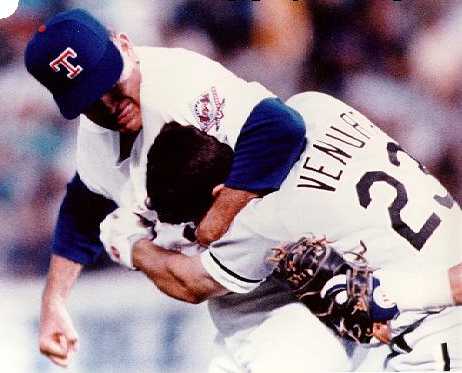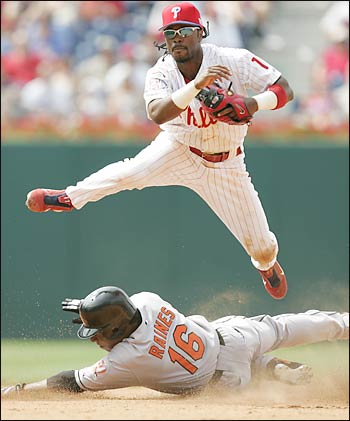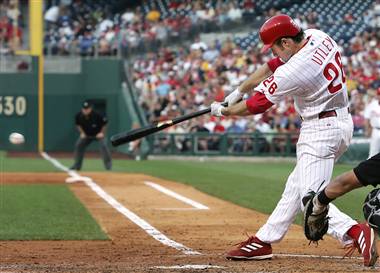
It started off as a casual conversation about the rumored ongoing negotiations between the Phillies Front Office and SP Jamie Moyer. Most Phillies fans have been clamoring to resign Moyer at any cost. "He's earned it" is the general consensus among even knowledgable fans. The current rumor mill has Moyer asking for a 2 year deal with a possible option year for a 3rd season. The Phillies are said to be offering a 1 year deal with a option for a 2nd season. Moyer turned 46 two weeks ago and there aren't alot of comparable 46 year old pitchers that have had good, or even passable seasons. Off the top of my head, I was able to throw out names like Phil Niekro, Charlie Hough, Satchel Paige, Tommy John, Nolan Ryan and even Hoyt Wilhelm. After a quick jaunt over to Wikipedia, I came up with guys like Jack Quinn, Nick Altrock and Jessie Orosco. Mind you, that's a list of guys that have even pitched a season at age 46, not pitched well. That said, lets look a bit closer at how some of these guys aged from 45 to 46 and even to 47 if they actually pitched at that age (very few did).
Phil Niekro - Niekro was a medical marvel and was amazing for his longevity. This longevity can be laid at his ability to throw knuckleball after knuckleball after knuckleball to opposing hitters. He was also able to put up a respectable line in his Age 46 season.
Age 45: 31 GS, 16-8, 215 IP, 3.09 ERA, 123 ERA+, 1.368 WHIP
Age 46: 33 GS, 16-12, 220 IP, 4.09 ERA, 98 ERA+, 1.468 WHIP
Age 47: 33 GS, 11-11, 210 IP, 4.32 ERA, 96 ERA+, 1.597 WHIP
Niekro was unique in his ability to put up league average seasons at Age 46 and Age 47. He is both a knuckleballer and a Hall of Famer. Moyer is neither of those things. Even with his efforts, there is a clearly discernable decline in Niekro's numbers, especially in his WHIP rate. Niekro was quite hittable in his final two seasons and this brought up his numbers significantly.
Charlie Hough - Hough is another knuckleballer who hung around into the early nineties by pitching for the expansion club Florida Marlins. Hough's claim to fame (and trivia question answer) will be his place as the starting pitcher for the Marlins inaugural home opener. I remember watching that game on television as it was the nationally televised game that week. That being said, Hough suffered a drastic decline in his numbers from Age 45 to Age 46 and he retired after his Age 46 season.
Age 45: 34 GS, 9-14, 204 IP, 4.27 ERA, 100 ERA+, 1.336 WHIP
Age 46: 21 GS, 5-9, 113 IP, 5.15 ERA, 84 ERA+, 1.496 WHIP
As you can see, Hough was done after his Age 45 season in 1993 and it was a huge mistake for him to come back in 1994 for another year. At the time of the strike, he had an ERA in the low 5's and was ineffective at best as a starter.
Satchel Paige - There are a few issues with including Satchel on this list. For one, no one has any idea what his true age was when he entered the Majors. Another issue is that he pitched mainly out of the bullpen despite a small number of spot starts. He is simply a unique player with no comparables. However, here's the breakdown of his numbers:
Age 45: 6 GS, 47 G, 12-10, 138 IP, 3.07 ERA, 127 ERA+, 1.254 WHIP
Age 46: 4 GS, 57 G, 3-9, 117 IP, 3.53 ERA, 119 ERA+, 1.304 WHIP
Paige also retired after his Age 46 season despite a short cameo at Age 58 where he pitched 3 innings for Kansas City in a start that was more publicity than anything else.
Tommy John - TJ is probably more well known to modern baseball fans for his association with the groundbreaking ligament-transplant surgery than his impressive pitching career. TJ pitched in the Majors from 1963-1989. Like most other aging pitchers, he suffered a drastic decline in his numbers from Age 45 to Age 46.
Age 45: 32 GS, 9-8, 176 IP, 4.49 ERA, 89 ERA+, 1.514 WHIP
Age 46: 10 GS, 2-7, 63 IP, 5.80 ERA, 66 ERA+, 1.712 WHIP
TJ was a non-factor in his final season. Considering his extremely high WHIP, his ERA is probably lower than it should be...this despite it being an Adam Eatonesque 5.80.
Nolan Ryan - Nolan is one of my favorite pitchers of all time. Simply put, no one could bring the heat like ol' Ryan. By bringing the heat, I mean his seeming nonchalance at beating Robin Ventura senseless (See Above Picture) when he was dumb enough to charge the mound against this ornery Texan. That said, Nolan was another pitcher who probably should have retired after his Age 45 season.
Age 45: 27 GS, 5-9, 157 IP, 3.72 ERA, 103 ERA+, 1.316 WHIP
Age 46: 13 GS, 5-5, 63 IP, 4.88 ERA, 85 ERA+, 1.417 WHIP
While Ryan's ERA+ was still a somewhat respectable 85, he struggled with injuries in his Age 46 season and was mainly ineffective because of this.
Hoyt Wilhelm - Who the hell is Hoyt Wilhelm? Yeah, that's gonna be alot of people's reactions unless they like obscure Hall of Fame knuckleball-throwing relievers. I remember him simply from his plaque in Cooperstown because of his odd name. Other than that, he was just another name to me. That said, he is on that short list of guys who pitched in the Majors at Age 46. Downside with Hoyt: He was a reliever.
Age 45: 72 G, 4-4, 93 IP, 1.73 ERA, 184 ERA+, 0.993 WHIP
Age 46: 52 G, 7-7, 78 IP, 2.19 ERA, 159 ERA+, 0.923 WHIP
Age 47: 53 G, 6-5, 82 IP, 3.40 ERA, 124 ERA+, 1.402 WHIP
Hoyt was very respectable as a reliever through his Age 47 season. He was also a reliever who relied on the knuckleball. Hoyt also pitched two more seasons retiring at the end of his Age 49 season. Though in those final two seasons, he only chipped in around 20 IP each year.
Out of those six pitchers, four retired after their Age 46 season (Hough, Paige, Ryan, John). Out of those four, only Paige had an above average season at Age 46 and he was a reliever. Phil Niekro and Hoyt Wilhelm both pitched in their Age 47 seasons. However, as I just mentioned, Wilhelm was a specialist reliever. Niekro was the only player mentioned that actually pitched primarily as a starter at Age 47. Niekro is unique in that respect. He even managed to post pretty respectable numbers at Age 47. He posted an ERA+ of 96 (100 is the equivalent of a league-average starter). Out of the four who retired at Age 46, Charlie Hough and Tommy John had ERAs well above 5 and Nolan Ryan came in with a 4.88 ERA. None of those four managed to pitch even close to 200 innings. In fact, Phil Niekro is the only guy in the history of baseball to pitch 200+ innings at Age 46 or Age 47.
What does all this mean? It means that the odds of Jamie Moyer having another above-average season at Age 46 are remote. He beat the odds at Age 45 posting very impressive numbers while he helped the Phillies win their first World Series in 28 years. However, the odds are stacked against him playing out a two-year deal with any level of respectability.
Its probably even money for Moyer to put up a league-average season next year. Niekro did it but then Niekro was a knuckleballer. Like Niekro, Moyer has a unique set of skills and that works in his favor. He doesn't rely on a blazing fastball like Nolan Ryan. He relies on pinpoint control, working the black and fooling young, aggressive hitters. He out thinks his opponent, he doesn't overpower them. If he can stay healthy and keep his stamina, he's got a shot. Staying in baseball shape at age 46 is very hard to do. If Moyer is able to do it, he will be on a very short list of players who have done so.






